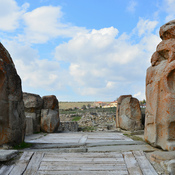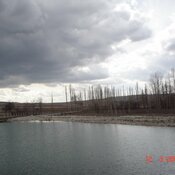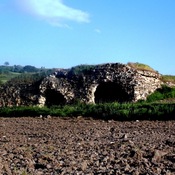Er zijn nog geen Nederlandstalige annotaties. Hier volgen annotaties in het Engels.
The hill at Alacahöyük was first described by W.C. Hamilton in 1835 and this year started the first excavations. Alacahöyük was an important centre of the fourth millenium BC. The ethnic identity of Alaca’s preliterate inhabitants is uncertain, it is most plausible to assign them to the non-Indo-European population that lived there before the arrival of Hittites. The first findings in Alacahöyük archaeological researches take them back to 3500 BC. The Hatti Period, which lasted until about 1750 BC in Central Anatolia, ended when the Hittites came to Anatolia and established their kingdom. However, the traces of the Hatti culture continued in the Hittite Civilization. During the Hittite Imperial Age, Alaca Höyük seems to have been an important cult center with its temple-palace, clean and waste water channels, two monumental gates.
- Kurt Bittel: Die Hethiter - Die Kunst Anatoliens vom Ende des 3. bis Anfang des 2. Jahrtausends vor Christus. C. H. Beck München 1976, Ipp. 30–48
- Maciej Popko: Zippalanda and Ankuwa once more. Journal of the American Oriental Society 120/3, 2000, 445-448.
- Piotr Taracha, The Iconographic Program of the Sculptures of Alacahöyük, Journal of Ancient Near Eastern Religions, 11 , 2011, pp. 132-147
- Joost Blasweiler, The Kalehisar mountain and the deities of Arinna, the city of the Sun Goddess, Arnhem (nl) 2017 – 1 Anatolia in the bronze age - https://www.academia.edu/30853831
- Ayse Gursan-Salzmann, Alaca Hoyuk: A reassessment of the excavation and sequence of the Early Bronze Age settlement, University of Pennsylvania, 1992
The hill at Alacahöyük was first described by W.C. Hamilton in 1835 and this year started the first excavations. Alacahöyük was an important centre of the fourth millenium BC. The ethnic identity of Alaca’s preliterate inhabitants is uncertain, it is most plausible to assign them to the non-Indo-European population that lived there before the arrival of Hittites. The first findings in Alacahöyük archaeological researches take them back to 3500 BC. The Hatti Period, which lasted until about 1750 BC in Central Anatolia, ended when the Hittites came to Anatolia and established their kingdom. However, the traces of the Hatti culture continued in the Hittite Civilization. During the Hittite Imperial Age, Alaca Höyük seems to have been an important cult center with its temple-palace, clean and waste water channels, two monumental gates.
- Kurt Bittel: Die Hethiter - Die Kunst Anatoliens vom Ende des 3. bis Anfang des 2. Jahrtausends vor Christus. C. H. Beck München 1976, Ipp. 30–48
- Maciej Popko: Zippalanda and Ankuwa once more. Journal of the American Oriental Society 120/3, 2000, 445-448.
- Piotr Taracha, The Iconographic Program of the Sculptures of Alacahöyük, Journal of Ancient Near Eastern Religions, 11 , 2011, pp. 132-147
- Joost Blasweiler, The Kalehisar mountain and the deities of Arinna, the city of the Sun Goddess, Arnhem (nl) 2017 – 1 Anatolia in the bronze age - https://www.academia.edu/30853831
- Ayse Gursan-Salzmann, Alaca Hoyuk: A reassessment of the excavation and sequence of the Early Bronze Age settlement, University of Pennsylvania, 1992








































































